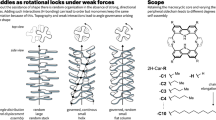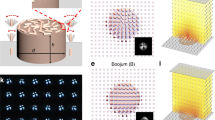Abstract
The shapes of two-dimensional (2D) nanostructures on surfaces are determined by their boundary energies1,2,3 as well as by long-range elastic, electrostatic or magnetic interactions. Although it is well known that long-range interactions can give rise to shape bifurcation4,5,6,7,8,9—an abrupt change in shape symmetry at a critical size—a general description of the evolution of shape with size, systematically incorporating both the azimuthal dependence of the boundary energy and long-range interactions, has been lacking. Here we show that unconstrained shape relaxation, including previously ignored boundary curvature, leads to a novel, continuous shape change from convex at small size to concave at large size. In addition to demonstrating a method to quantitatively determine the azimuthal dependence of the boundary energy, we show that the energy gain associated with boundary curvature relaxation is a key factor in stabilizing surface nanostructures. For 7×7 domains on Si(111), boundary curvature reduces the formation free-energy by up to 50%.
This is a preview of subscription content, access via your institution
Access options
Subscribe to this journal
Receive 12 print issues and online access
$259.00 per year
only $21.58 per issue
Buy this article
- Purchase on Springer Link
- Instant access to full article PDF
Prices may be subject to local taxes which are calculated during checkout



Similar content being viewed by others
References
Wulff, G. Velocity of growth and dissolution of crystal faces. Z. Kristallogr. 34, 449–530 (1901).
Herring, C. Some theorems on the free energies of crystal surfaces. Phys. Rev. 82, 87–93 (1951).
Hannon, J.B., Tersoff, J. & Tromp, R.M. Surface stress and thermodynamic nanoscale size selection. Science 295, 299–301 (2002).
Johnson, W.C. & Cahn, J.W. Elastically induced shape bifurcations of inclusions. Acta Metall. 32, 1925–1933 (1984).
McCormack, M., Khachaturyan, A.G. & Morris, J.W. Jr A two-dimensional analysis of the evolution of coherent precipitates in elastic media. Acta Metall. Mater. 40, 325–336 (1991).
Brongersma, S.H., Castell, M.R., Perovic, D.D. & Zinke-Allmang, M. Stress-induced shape transition of CoSi2 clusters on Si(100). Phys. Rev. Lett. 80, 3795–3798 (1998).
Li, A., Liu, F. & Lagally, M.G. Equilibrium shape of two-dimensional islands under stress. Phys. Rev. Lett. 85, 1922–1925 (2000).
Middel, M.T., Zandvliet, H.J.W. & Poelsema, B. Surface stress anisotropy. Phys. Rev. Lett. 88, 196105 (2002).
Tersoff, J. & Tromp, R.M. Shape transition in growth of strained islands: spontaneous formation of quantum wires. Phys. Rev. Lett. 70, 2782–2785 (1993).
Alerhand, O.L., Vanderbilt, D., Meade, R.D. & Joannopoulos, J.D. Spontaneous formation of stress domains on crystal surfaces. Phys. Rev. Lett. 61, 1973–1976 (1988).
Marchenko, V.I. Possible structures and phase transitions on the surface of crystals. JETP Lett. 33, 381–383 (1981).
Zielasek, V., Liu, F., Zhao, Y., Maxson, J.B. & Lagally, M.G. Surface stress induced island shape transition in Si(001) homoepitaxy. Phys. Rev. B 64, 201320 (2001).
Doi, M. Elasticity effects on the microstructure of alloys containing coherent precipitates. Prog. Mater. Sci. 40, 79–180 (1996).
Thompson, M.E., Su, C.S. & Voorhees, P.W. The equilibrium shape of a misfitting precipitate. Acta Metall. Mater. 42, 2107–2122 (1994).
Schmidt, I. & Gross, D. The equilibrium shape of an elastically inhomogeneous inclusion. J. Mech. Phys. Solids 45, 1521–1549 (1996).
Tromp, R.M., Mankos, M., Reuter, M.C., Ellis, A.W. & Copel, M. A new low energy electron microscope. Surf. Rev. Lett. 5, 1189–1197 (1998).
Tromp, R.M. & Hannon, J.B. Thermodynamics of Nucleation and Growth. Surf. Rev. Lett. 9, 1565–1593 (2002).
Tweston, R.D. & Gibson, J.M. Measurement of Si(111) surface stress by a microscopic technique. Phys. Rev. B 50, 17628–17631 (1994).
Vanderbilt, D. Phase segregation and work-function variations on metal surfaces: spontaneous formation of periodic domain structures. Surf. Sci. 268, L300–L304 (1992).
Seul, M. & Andelman, D. Domain shapes and patterns: The phenomenology of modulated phases. Science 267, 476–483 (1995).
Marchenko, V.I. Domain-structure in oxygen on a Cu(110) surface. Sov. Phys. JETP Lett. 55, 73–76 (1992).
Acknowledgements
We are grateful to N. C. Bartelt, F. Leonard and M. C. Reuter for helpful discussions.
Author information
Authors and Affiliations
Corresponding author
Ethics declarations
Competing interests
The authors declare no competing financial interests.
Rights and permissions
About this article
Cite this article
Thayer, G., Hannon, J. & Tromp, R. Shape and stability of self-assembled surface domains. Nature Mater 3, 95–98 (2004). https://doi.org/10.1038/nmat1050
Received:
Accepted:
Published:
Issue Date:
DOI: https://doi.org/10.1038/nmat1050



